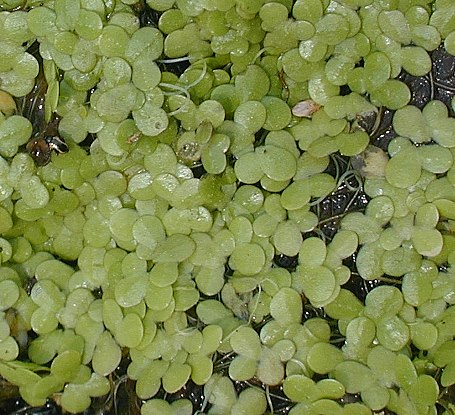Description: This floating aquatic plant consists of a single oval or oval-obovate thallus (a body that combines the functions of leaf and stem); it is about 2-5 mm. long and 1.5-3.5 mm. across. The thallus has a slightly succulent texture and smooth margins; it is able to float on water because of numerous tiny air bubbles that are imbedded within its interior. The upper thallus surface is medium green and slightly convex along a faint longitudinal ridge; the lower thallus surface is light green and flat. Both surfaces are glabrous. Under magnification, 3 interior veins are usually visible (a central vein and 2 lateral veins) within the body of the thallus. A single rootlet up to 2 cm. long (rarely longer) develops near the center of the thallus' lower surface. This rootlet is slender and white with a tip that is usually obtuse. At the base of the rootlet, there is a short cylindrical sheath.

On rare occasions,
a single tiny flower is produced that spans about 1 mm. across. This
flower consists of a membranous cup-shaped scale, a single pistil, and
2 anthers. Flowers can be produced anytime between late spring to early
fall. The flower is replaced by a single fruit (1 mm. in length or a
little less) that contains a single ribbed seed. However, this plant
reproduces primarily by a budding process from two lateral reproductive
pouches. The offsets of this budding process are identical genetically
to the mother plant. An offset is connected to the mother plant by a
slender white stipe, but this soon withers away. During the summer,
Common Duckweed often forms dense colonies of plants from budding.
During the cooler weather of fall, small starchy buds called 'turions'
are produced that sink to the bottom of the water body. This dormant
state continues until the warmer weather of spring, when the turions
rise to the water surface and the growth process begins again.
Cultivation:
This plant adapts to fresh water that is stagnant or slow-moving and
relatively high in nutrients. It has a fairly wide pH tolerance. Full
or partial sun is required. This plant can spread aggressively and may
cover the entire surface of a small body of water in some circumstances.
Range & Habitat:
Common Duckweed occurs throughout Illinois; it is the most common Lemna
sp. (Duckweed) in the state. This species is native to
Illinois and it is widely distributed throughout the world. Habitats
include ponds and lakes, slowing moving creeks and rivers, vernal
pools, marshes, and ditches. This duckweed is common in disturbed and
degraded wetlands, although it also occurs in higher quality wetlands.
Faunal Associations:
Müller (1873/1883) has speculated that insects living on the surface of
the water are the pollinators of the rarely produced flowers. A small
number of insects feed on the thalli of Lemna spp.
(Duckweeds). These species include Rhopalosiphum nymphaeae
(Water Lily Aphid), Scirtes tibialis (Duckweed
Beetle), Tanysphyrus lemnae (Duckweed Weevil),
maggots of Lemnaphila
scotlandae (Lemna Fly), and Sminthurides aquaticus (Water
Springtail). The larvae of several moths also feed on the thalli,
including Munroessa
icciusalis (Pondside Pyralid Moth), Neocataclysta magnificalis (Scrollwork
Pyralid Moth), Synclita
obliteralis (Waterlily Leafcutter Moth), and Synclita tinealis (Black
Duckweed Moth); see Harms & Grodowitz (2009), Covell
(1984/2005), Scotland (1940), and Kraatz (1918). Some vertebrate
animals also feed on Lemna
minor (Common Duckweed)
and other duckweeds, especially ducks and turtles. Examples of wetland
birds that feed on these plants include the Wood Duck, Green-winged
Teal, Mallard, Ring-necked Duck, Trumpeter Swan, American Coot, and
Sora Rail (the Bird Table has a
more complete listing of these species). The following turtles are
known to feed on duckweed to
varying degrees: Chelydra serpentina (Snapping
Turtle), Chrysemys picta (Painted Turtle), Emydoidea
blandingii (Blanding's Turtle), Graptemys
ouachitensis (Ouachita Map Turtle), Kinosternum
flavescens (Yellow Mud Turtle), and Trachemys
scripta (Slider); see Lagler (1943) and Ernst et al. (1994) for more information.
Duckweeds are a source of food for several freshwater fishes, including
Ictiobus spp. (Buffalofish), Moxostoma carinatum (River
Redhorse), Lepomis
gibbosus (Pumpkinseed), Cyprinus carpio (Common
Carp), Notemigonus
crysoleucas (Golden Shiner), Ameiurus spp. (Bullhead
Catfish), and Umbra
limi (Central Mudminnow); see Forbes (1888) and Pearse
(1918) for more information. Because the rootlets of duckweed are
sticky when they are wet, ducks and other wetland birds can carry this
plant from one body of water to another, introducing it to new wetland
areas.
Photographic Location:
The photograph was taken at a pond of Crystal Lake Park in Urbana,
Illinois.
Comments:
To some people, duckweed may appear to be some kind of algae, but they
rank among the smallest of all flowering plants. The different species
of duckweed are often difficult to distinguish from each other, and an
instrument with 10x magnification or higher is often necessary to make
a correct identification. Two other groups of similar-looking plants
are the Wolffia (Watermeal) and Spirodela
(Greater Duckweed). Like duckweed, these species are floating aquatics
consisting of small individual thalli. However, species of Watermeal
tend to be smaller in size and lack rootlets, while species of Greater
Duckweed tend to be larger in size and have 2 or more rootlets per
thallus. Another common name of Lemna minor is
Lesser Duckweed.